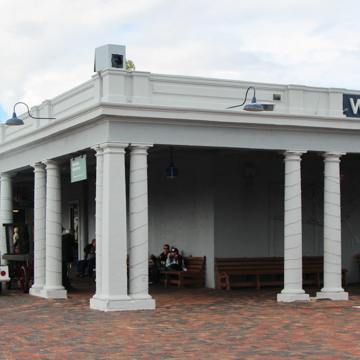You are here
Grand Canyon Railway and Hotel
Sited north of Route 66 and the parallel tracks of the Atchison, Topeka and Santa Fe Railway, the Fray Marcos Hotel was an inn within the AT&SF depot at Williams, which served as a stop on the railway’s main line between Chicago and Los Angeles and as the southern terminus of the 65-mile railway spur to the Grand Canyon. Opened in 1908, the hotel was one of the Harvey Houses, combination restaurants- inns managed by the Fred Harvey Company, concessionaires to the AT&SF. Named for Marcos de Niza, a Spanish missionary who accompanied Coronado’s expedition through the American Southwest in 1540, the hotel has an ambiance intended to evoke the region’s Spanish Colonial heritage, capitalizing on what appeared exotic to eastern tourists in the early twentieth century. President Franklin D. Roosevelt was among the hotel’s many notable guests.
As early as 1901, Fred Harvey had built a small curio shop on the present site, separated from Williams’ downtown by the railroad tracks. By 1907, the AT&SF decided to expand its commercial enterprise and commissioned architect Francis Wilson to design a 21-room, Mission Revival hotel under Fred Harvey Company management. Work began the following year on the two-story hotel and one-story attached depot (located on the eastern end). Both were constructed entirely of reinforced concrete and the joint structure it is one of the largest and oldest examples of poured concrete architecture in the state. Following the tradition of Harvey Houses, which offered quality dining at fair prices, the Fray Marcos featured a lunch room and a formal dining room, along with a newsstand and an “Indian Room” that sold handicrafts made by local Native Americans.
Between 1923 and 1925, the hotel was enlarged with a north wing containing 22 additional guestrooms. The Mission Revival idiom of the original building was morphed into a Renaissance Revival style. The rambling villa-cum-depot featured a Tuscan-order colonnade around the railway station and groups of four rounded or squared Doric columns at the corners of the flat roof; Italianate window surrounds on the hotel; and bracketed flat hood moldings. The hotel’s main entrance faced the railroad tracks and the town beyond, marked by a segmented arch.
In 1960, the railroad’s mainline bypassed Williams; the station closed in 1967 and the Fray Marcos buildings quickly fell into disrepair. Architectural features, including the hotel’s balconies and the depot’s balustrade parapet, were soon lost. The Grand Canyon Railway was resurrected in 1989 and the depot was partially restored in 1990, but today the sprawling Grand Canyon Railway Hotel, built in 1995, obscures the Fray Marcos, which now serves as a gift shop and office space. The attached depot maintains its original function for the Grand Canyon Railway and is open to the public.
References
Hoffman, Charles A., “Fray Marcos Hotel,” Coconino County, Arizona. Arizona State Historic Property Inventory, No. WMB-3, 1983. Arizona State Historic Preservation Office, Phoenix, Arizona.
Potter, Janet Greenstein. Great American Railroad Stations. New York: John Wiley and Sons, 1996.
Richmond, Al, “Grand Canyon Railway,” Coconino County, Arizona. National Register of Historic Places Registration Form, 1998. National Park Service, U.S. Department of the Interior, Washington, D.C.
Writing Credits
If SAH Archipedia has been useful to you, please consider supporting it.
SAH Archipedia tells the story of the United States through its buildings, landscapes, and cities. This freely available resource empowers the public with authoritative knowledge that deepens their understanding and appreciation of the built environment. But the Society of Architectural Historians, which created SAH Archipedia with University of Virginia Press, needs your support to maintain the high-caliber research, writing, photography, cartography, editing, design, and programming that make SAH Archipedia a trusted online resource available to all who value the history of place, heritage tourism, and learning.





